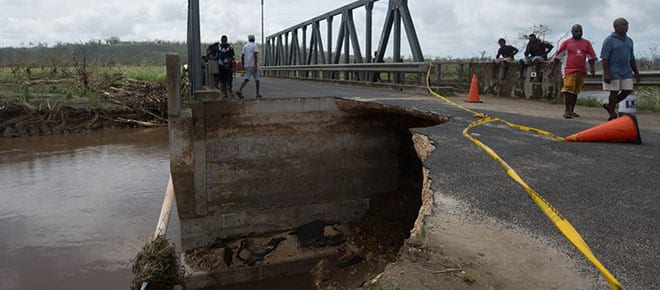Oxfam’s 10 person team in Vanuatu is reporting damage to major infrastructure like the hospital, the morgue and schools as the picture of complete devastation in Vanuatu now begins to unfold.

Oxfam’s 10 person team in Vanuatu is reporting damage to major infrastructure like the hospital, the morgue and schools as the picture of complete devastation in Vanuatu now begins to unfold.
Oxfam Country Director in Port Vila, Colin Collet van Rooyen, said the damage to things as important as the morgue, the hospital and schools could create major problems in the coming days that would compound the devastation left by Cyclone Pam.
“At least 90% of housing here in Port Vila has been badly damaged, the kids have nowhere to go to school, there is no power at the hospital which has also flooded in parts and damage to the state mortuary means we need a temporary mortuary set up quickly,” Mr Collett van Rooyen said.
“Clean water, sanitation and hygiene supplies are also a major issue for those left homeless and also those in evacuation centres, where there simply are not enough toilets or clean water for the amount of people in those facilities. The scenes we are seeing today are just devastating with entire communities gone.”
Oxfam New Zealand’s Executive Director Rachael Le Mesurier said “It’s becoming increasingly clear that we are now dealing with worse than the worst case scenario in Vanuatu, this is likely to be one of the worst disasters ever seen in the Pacific.”
“The initial contribution by the New Zealand government of $1 million to assist Pacific nations hit by Cyclone Pam, announced by Foreign Affairs Minister Murray McCully earlier today, will play an important role in the response” said Ms Le Mesurier
Ms Le Mesurier also announced that Oxfam New Zealand had now launched a full scale appeal to help the many thousands of people affected by the devastating cyclone.
Cyclone Pam made a direct hit on Vanuatu on Friday night, tearing through the archipelago with winds of up to 250kmh.
With more than 250,000 people at risk from the severe tropical cyclone there is real concern of a potentially high death toll and of enormous destruction, particularly given the traditional housing that is so prevalent through the islands. Ms Le Mesurier said grave fears were held for those people on the outer islands with little or no protection from the 250kmh winds.
Port Vila was recently named in the Natural Hazards Risk Atlas and is known as the city most exposed to natural disasters in the world because it faces a combination of risks including earthquakes, tsunamis, flooding and tropical cyclones such as Cyclone Pam.
You can support Oxfam’s response by donating to our Cyclone Pam Appeal at https://www.oxfam.org.nz/donate/pam or calling 0800 600 700
Donate to Oxfam’s Cyclone Pam response
New photos of #CyclonePam destruction in areas outside Port Vila posted by #HumansOfVanuatu https://t.co/xfk1gU538u pic.twitter.com/II5qf0FgUe
— Oxfam New Zealand (@oxfamnz) March 15, 2015
Royal Australian Air Force landed in #Vanuatu #CyclonePam #TCPam Photo: Joshua Aru pic.twitter.com/LGscjPLMpv
— Kenneth Dimalibot (@justcallmelloyd) March 15, 2015
@OxfamAustralia and others now in the air en route to #Vanuatu to assist in #CyclonePam response pic.twitter.com/jRoADHYjo5
— Louise Perry (@LouiseAPerry) March 14, 2015





